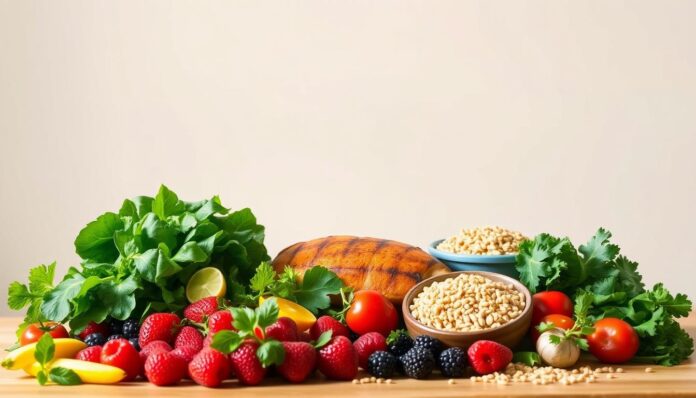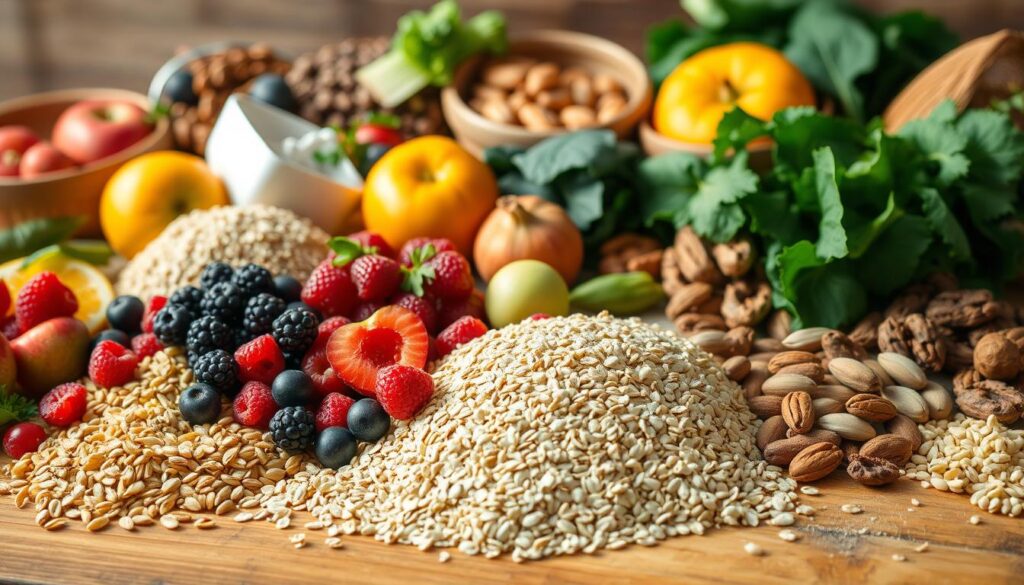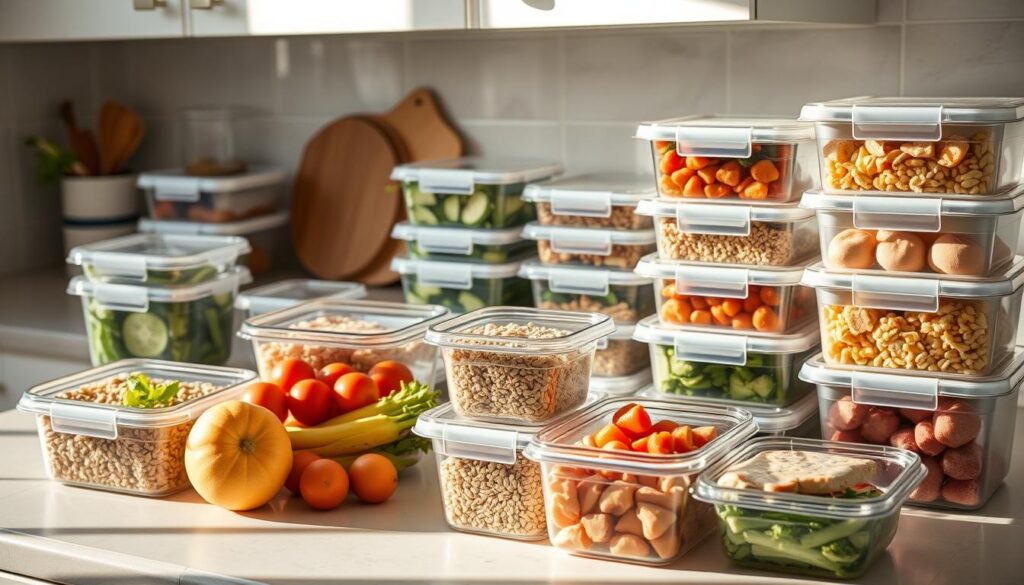Imagine walking into your kitchen with a goal: to make meals that are good for your body and help you lose weight. Many people, like you, have tried different diets and food trends. But the real secret to losing weight is knowing what you eat, focusing on the best foods for weight loss.
Think about this: a cup of raisins has about 480 calories, while a cup of grapes has only 104. These numbers show how calorie-dense foods are. By choosing healthy foods, you’re not just counting calories. You’re picking foods that make you feel full without too many calories. For example, half a grapefruit has only 64 calories and is mostly water, making it a great choice for eating more without gaining weight.
This guide will give you the knowledge you need about foods that are full of nutrients and help you feel full. You’ll learn about proteins, fibrous fruits and veggies, and whole grains that are good for you. Together, we’ll find the best foods to change your eating habits and help you reach your health goals.
Key Takeaways
- Understanding energy density helps in making informed food choices.
- Opting for low-calorie, high-volume foods can assist with weight loss.
- High-protein foods support satiety and muscle maintenance.
- Incorporating fiber-rich foods can increase feelings of fullness.
- Variety in your diet, particular with whole foods, enhances nutrition.
Understanding Weight Loss and Nutrition
Learning about weight loss nutrition is key to reaching your health goals. At its heart, losing weight is about balancing calories in and out. You need to eat fewer calories than you burn to lose weight. Also, getting the right mix of macronutrients is vital for your body’s health and performance.
The Science Behind Weight Loss
Weight loss is a mix of biology and behavior. Studies reveal only 1 to 3 percent of people keep off the weight they lose. Adding more exercise can lead to short-term weight loss of 2 to 3 kg. Combining exercise with eating less can lead to more weight loss over time.
Calories In vs. Calories Out
The idea of calories in vs. out is key to losing weight. You can lose weight by eating less or moving more. Aiming for 2,000 to 3,000 kcal of activity a week can help. Long-term success often comes from tracking what you eat and joining support groups.
Macronutrients Explained
Getting the right balance of macronutrients is important for weight loss. Proteins, fats, and carbs each have their own role. Foods high in protein, like lean meats and beans, help you feel full. Eating foods high in fiber also makes you feel full longer. Keeping track of what you eat helps you stay on track.
| Macronutrient | Role in Nutrition | Sources |
|---|---|---|
| Protein | Supports muscle maintenance and enhances satiety | Lean meats, fish, beans, dairy |
| Fats | Provides energy and supports cell structure | Nuts, avocados, olive oil |
| Carbohydrates | Main energy source for bodily functions | Whole grains, fruits, vegetables |
The Role of Protein in Your Diet
Protein is key in any diet, and it’s even more important when you’re trying to lose weight. Foods high in protein help keep your muscles strong and make you feel full. This makes it easier to eat less and manage your calories.
Research shows that eating more protein can make you feel fuller. It also helps lower levels of a hunger hormone called ghrelin. Adding lean protein sources to your meals can help you reach your health goals.
Benefits of High-Protein Foods
Eating protein-rich meals has many benefits. For one, your body burns more calories when you digest protein. This is unlike carbs and fats, which burn fewer calories.
Also, eating 30% of your daily calories as protein can help you eat fewer calories overall. Studies show that a high-protein diet can lead to losing around 11 pounds in 12 weeks.
Best Sources of Lean Protein
Choosing the right lean protein sources is important. It helps you get enough protein without eating too many calories. Here are some great options:
| Protein Source | Protein Content (g per 100g) | Fat Content (g per 100g) |
|---|---|---|
| Chicken Breast | 31 | 3.6 |
| Legumes (Lentils) | 9 | 0.4 |
| Greek Yogurt | 10 | 0.4 |
| Eggs | 13 | 10.6 |
| Tofu | 8 | 4.8 |
Incorporating Protein into Meals
To lose weight, it’s important to eat more protein. Start your day with a protein-rich breakfast, like eggs or Greek yogurt. Add lean meats like chicken or turkey to your lunch and dinner.
Snacks like cottage cheese or a protein shake can also help. Aim for 0.7 to 1 gram of protein per pound of lean body mass. This can help you enjoy the many benefits of high-protein foods.
Healthy Fats for Weight Management
Adding healthy fats to your diet helps with weight control. It’s key to know the difference between good and bad fats. Good fats, like monounsaturated and polyunsaturated, are good for you and help with weight. Bad fats can cause health problems.
Understanding Healthy vs. Unhealthy Fats
Healthy fats come from plants and some fish, which are good for your heart. Foods like olive oil, avocados, and nuts are full of monounsaturated fats. Polyunsaturated fats are found in fish and flaxseed. On the other hand, bad fats are in processed foods, red meats, and high-fat dairy. The Dietary Guidelines say adults should get 20% to 35% of their calories from fats, but less than 10% should be saturated.
Top Sources of Heart-Healthy Fats
Adding certain foods to your diet can boost your intake of healthy fats. Here are some good sources:
| Food Source | Type of Fat | Serving Size | Calories |
|---|---|---|---|
| Olive Oil | Monounsaturated | 1 tablespoon | 120 |
| Avocado | Monounsaturated | 1/2 medium | 160 |
| Walnuts | Polyunsaturated | 1 ounce | 185 |
| Fatty Fish (e.g., Salmon) | Omega-3 Polyunsaturated | 3 ounces | 175 |
Balancing Fat Intake in Your Diet
Getting the right amount of fat is important for weight and health. Eating a Mediterranean diet, full of healthy fats, can help keep weight off. Switching red meat for fish can cut calories by 4% to 9%. Eating healthy fats like avocados or nuts can make you feel full and help you eat better. Choose quality fats and watch your portions for the best results.
Fiber-Rich Foods for Satiety
Eating foods high in fiber can help you lose weight. Fiber makes you feel full, which helps control hunger and cut down on calories. The average American gets only 10-15 grams of fiber a day, which is less than the 35-50 grams they should aim for.
Adding more fiber to your diet can improve your digestion and lower the risk of serious diseases.
Importance of Fiber in Weight Loss
Fiber helps you feel full, which is key for weight management. Foods high in fiber can make you absorb fewer calories than foods low in fiber. They also hold more water, making your meals feel bigger and helping with digestion.
Also, fiber slows down digestion, keeping you feeling full longer. Studies link high-fiber diets to less obesity and chronic diseases.
Best Sources of Dietary Fiber
Many foods are great sources of dietary fiber. Here are some top picks to boost your fiber:
- Beans: They’re full of protein and fiber, helping you stay full.
- Whole grains: Foods like quinoa and oats are fiber-rich and nutritious.
- Fruits: Whole fruits, like apples and pears, keep their fiber, unlike fruit juices.
- Vegetables: Leafy greens, broccoli, and carrots are fiber-rich and full of vitamins.
- Legumes: Lentils and chickpeas are great for feeling full after meals.
Tips for Increasing Fiber Intake
Increasing your fiber intake can be done slowly to avoid stomach upset. Here are some tips:
- Begin your day with a fiber-rich breakfast, like oatmeal or whole grain toast.
- Add legumes to your meals, aiming for a few servings a week.
- Choose fruits and vegetables for snacks instead of processed foods.
- Go for whole grains over refined grains in bread, pasta, and rice.
- Drink plenty of water, as you increase your fiber.
The Power of Fruits and Vegetables
Adding fruits and vegetables to your diet can boost your weight loss efforts. They are full of nutrients and low in calories. This makes you feel full and gives you important vitamins and minerals. Eating a variety of low-calorie fruits and veggies can improve your health and help with weight management.
This section will look at the best choices and why it’s important to have different colors in your meals.
Low-Calorie Fruits That Aid Weight Loss
Low-calorie fruits are great for those trying to lose weight. Berries, apples, and citrus fruits add flavor and help with weight loss. Studies show eating more fruits can lower the risk of heart disease.
For example, a study found that eating more fruits can reduce heart disease risk by 4%. Choosing fruits low in calories helps keep your snacks healthy and satisfying.
Non-Starchy Vegetables to Include
Non-starchy veggies are key for weight loss because they’re low in calories but high in nutrients. Spinach, kale, cucumber, and bell peppers fill your plate without adding too many calories. The DASH study found that eating more of these veggies can lower blood pressure.
Eating them regularly helps with weight management and boosts fiber intake. This is good for your gut health and overall well-being.
Importance of Color Variety in Your Diet
Having a variety of colors in your meals means you get a wide range of nutrients. Different colors in fruits and veggies indicate various beneficial compounds. For instance, dark greens are full of vitamins, while red and purple fruits have antioxidants.
Try to have a “rainbow” plate. Eating a variety of colors can lead to better health, including a lower risk of chronic diseases and cancers.
| Fruit/Vegetable | Calories per Serving | Fiber (grams) | Health Benefits |
|---|---|---|---|
| Blueberries | 84 (1 cup) | 4 | Lowers risk of diabetes |
| Spinach | 7 (1 cup) | 1 | High in vitamins K and A |
| Broccoli | 55 (1 cup) | 5 | May help reduce cancer risk |
| Apples | 95 (medium) | 4 | Supports heart health |
| Carrots | 41 (1 cup) | 4 | Promotes eye health |
By focusing on low-calorie fruits, non-starchy veggies, and colorful produce, you can make a healthy, satisfying diet. This diet supports weight loss and long-term health.
Whole Grains vs. Refined Grains
It’s key to know the difference between whole grains and refined grains for better eating. Whole grains keep their bran, germ, and endosperm, packed with fiber and nutrients. Refined grains lose these parts, leading to less nutrition. Choosing whole grains is vital for health, like managing weight.
Benefits of Whole Grains
Whole grains offer many health perks. They boost heart health by improving cholesterol and reducing heart disease risk. Their fiber also helps with weight loss by keeping you full. The Dietary Guidelines suggest eating at least 50% whole grains, but many don’t.
Best Choices for Weight Loss
Adding whole grains to your meals can make your diet better and help with weight loss. Here are some great picks:
- Brown rice
- Quinoa
- Oats
- Whole-wheat products (bread, pasta, and crackers)
- Barley
- Millet
- Farro
- Wild rice
These foods are not just nutritious but also high in fiber. This makes them more filling and good for your health.
How to Replace Refined Grains
Switching to whole grains is easy and beneficial. Here’s how to do it:
- Choose whole-wheat products instead of white bread.
- Opt for brown rice instead of white rice.
- Incorporate whole grain pastas into favorite dishes.
- Snack on air-popped popcorn or whole-grain crackers.
By swapping refined grains for whole grains, you get more fiber. This makes your meals more nutritious and satisfying.
The Importance of Hydration
Hydration is key to losing weight and staying healthy. Drinking enough water helps your body work right and keeps your weight in check. Studies show that water boosts metabolism, controls hunger, and improves how well you move.
Adding water to your daily routine can help you reach your weight loss goals. It’s a simple step that can make a big difference.
Hydration’s Role in Weight Loss
Drinking water helps you eat less. A study showed that women who drank 500 mL of water before meals lost weight and body fat. This habit can cut down on calories you consume.
Drinking cold water also burns more calories. Your body works harder to warm it up. Staying hydrated also boosts your metabolism, helping you burn fat.
Best Fluids to Support Weight Management
Choosing the right drinks is important for managing weight. Water, herbal teas, and broth-based soups are good choices because they don’t add calories. Switching from sugary drinks to water can help you lose weight.
Adults should drink about 11 cups of fluid each day. Most of this comes from food and drinks. Drinking water instead of sugary drinks cuts down on calories, making it easier to stay at a healthy weight.
Tips for Staying Hydrated
Here are some tips to stay hydrated and support weight loss:
- Drink at least one 8-ounce glass of water with each meal.
- Keep a water bottle handy throughout the day to encourage regular consumption.
- Prioritize drinking water before meals to take advantage of appetite suppression benefits.
- Consider incorporating water-rich foods, such as fruits and vegetables, into your diet.
- Monitor your hydration levels by observing urine color; light yellow indicates adequate hydration.
Following these tips can help you lose weight and improve your health. For more tips on losing weight, check out workout routines for weight loss.
Meal Prep Strategies for Success
Effective meal prep strategies can make your weight loss journey easier. They also reduce the stress of daily cooking. By focusing on balanced meal planning, you include lean proteins, healthy fats, and fiber-rich ingredients. This not only keeps you full but also helps you meet your health goals.
Planning Balanced Meals
It’s key to plan meals with whole, minimally processed foods for lasting weight loss. Your meals should have fruits, vegetables, proteins, and whole grains. Eating nutrient-dense foods helps you stay in a calorie deficit for weight loss. Start by preparing dinners for just two to three days a week to make it easier.
Portion Control Techniques
Controlling portions is essential for managing your weight. Use measuring cups or smaller plates to keep portions right. Studies show that preselecting meals and controlling portions leads to healthier eating. Labeling your prepared food with dates also helps reduce waste.
Snacks that Won’t Derail Your Goals
Snacks can often throw you off track from your weight loss goals. Choose healthy snacks like fresh fruits, veggies with hummus, or mixed nuts. They’re nutritious and won’t break your portion control. Planning your snacks ahead helps stick to your meal prep and avoids high-calorie, processed foods. For more tips on efficient meal planning, check out further resources on meal prepping.
The Impact of Sugars and Processed Foods
Understanding the effects of added sugars and processed foods is key to a healthier lifestyle. These items often have empty calories and lack essential nutrients. This can greatly affect your health.
Ultra-processed foods make up about 57.9% of total energy intake in the U.S. A huge 89.7% of energy from added sugars comes from these foods. It’s vital to know and limit their intake.
Understanding Added Sugars
Added sugars are common in many diets, making up about 21.1% of calories from ultra-processed foods. Experts say added sugars should be less than 10% of daily intake. Yet, the average American consumes more than this, with 292.2 kcal from added sugars daily.
A 12-ounce can of soda is almost a full day’s worth of added sugars. It has around 39 grams, which is about 9 teaspoons.
Identifying Processed Foods to Avoid
It’s important to know how processed foods affect your health. Soft drinks, fruit drinks, cakes, and cookies are high in added sugars. Bread, desserts, sweet snacks, and breakfast cereals also contribute a lot.
Knowing how to read food labels helps find hidden sugars. These can have over 50 different names. Choosing whole foods is better for your health.
Healthier Alternatives to Processed Snacks
Switching to healthier snack options can greatly improve your diet. Whole grains and fiber-rich foods like fruits and vegetables are better. They reduce obesity risk and provide essential nutrients.
By choosing fresh produce and whole grains over ultra-processed snacks, you promote healthier eating. For more on balanced diets for families, visit this resource.
| Food Type | Amount of Added Sugars (% of Total Intake) |
|---|---|
| Soft Drinks | 17.1% |
| Fruit Drinks | 13.9% |
| Cakes, Cookies, and Pies | 11.2% |
| Breads | 7.6% |
| Desserts | 7.3% |
| Sweet Snacks | 7.1% |
| Breakfast Cereals | 6.4% |
| Ice Creams and Ice Pops | 5.9% |
Mindful Eating Practices
Mindful eating helps you have a better relationship with food. It makes eating more enjoyable and prevents overeating. This way, you become more aware of when you’re hungry, making your food choices more thoughtful.
Benefits of Eating Mindfully
Mindful eating has many benefits. It can help reduce binge eating and improve how you eat. People who practice mindfulness feel more aware of their food and fullness.
This awareness can help you lose weight. It helps you control eating when you’re emotional or influenced by others.
Techniques for Mindful Eating
Here are some ways to make eating more mindful:
- Eat slowly and enjoy each bite, so your body can feel full.
- Don’t eat while watching TV or using your phone.
- Notice the tastes, textures, and colors of your food.
- Use smaller plates to control how much you eat.
- Be thankful for your food and the act of eating.
How Mindfulness Affects Weight Loss
Mindfulness is linked to weight loss. Studies show that mindful eating can help people lose a lot of weight. For example, adults in a study lost an average of 4 pounds in 12 weeks.
Mindful eaters also make better food choices. They choose healthier foods, which helps them lose weight.
Supplements and Their Role in Diet
Exploring weight loss supplements can be confusing, with many claiming to help. It’s key to know the good and bad about these products. Supplements have different ingredients, and their effectiveness is often debated. Getting advice from a healthcare provider is important for making smart choices.
Common Supplements for Weight Loss
Many weight loss supplements are out there, like raspberry ketone, caffeine, and ginger extract. A study with 70 adults showed a mix of these supplements helped them lose 4.2 pounds in eight weeks. This is more than the 0.9 pounds lost by those taking a placebo. But, it’s important to look at all the evidence and think about your health before starting any supplement.
Pros and Cons of Diet Supplements
Thinking about weight loss supplements means looking at both sides. They might be easy to use and could help you lose weight faster. But, there are big downsides. Some supplements haven’t been well tested, and they might have hidden dangers. They could also cause allergies or interact with your medicines.
Knowing the pros and cons can help you avoid risks or wasting money. Eating well and staying hydrated are key for lasting weight loss. For more nutrition tips, check out this link.
Consulting a Professional Before Use
Always talk to a healthcare provider before starting any weight loss supplements. They can check your health and decide if supplements are right for you. They can also tell you if you need them along with changes in your lifestyle.
More than two-thirds of adults in the U.S. are overweight or obese. This shows how important a full plan is. It should include a healthy diet, exercise, and advice from a professional.
Creating Your Personalized Weight Loss Plan
Starting a journey to a healthier lifestyle means making a personalized weight loss plan. A good plan fits your likes and sets goals that are reachable and lasting. Try the Mayo Clinic Diet, which aims for 6 to 10 pounds lost in the first phase. It focuses on lasting lifestyle changes, not quick fixes.
Setting Realistic Goals
It’s key to set goals that you can stick to. Aim to lose 1 to 2 pounds a week after the first phase. This slow pace helps your body get used to new foods and keeps you motivated. It’s all about making progress that you can keep up with.
Food Journaling and Tracking
Tracking what you eat helps you stay on track. A food journal lets you see patterns and make better choices. It keeps you interested and helps you fine-tune your plan as you go.
Adjusting Your Diet for Long-Term Success
As you keep losing weight, be ready to make changes. Update your diet based on what works and what doesn’t. Adding veggies or planning healthy meals are good steps. See this as a journey to better health, not a quick fix.
FAQ
What are the best foods for weight loss?
For weight loss, eat foods high in protein like chicken and eggs. Also, choose fiber-rich foods like beans and whole grains. Add healthy fats from avocados and nuts. Don’t forget fruits and vegetables. These foods are full of nutrients and help you feel full.
How do macronutrients affect weight loss?
Macronutrients are proteins, fats, and carbs. They keep your energy up and support health. Foods high in protein make you feel full. Healthy fats help you feel satisfied and absorb nutrients better. They’re key for managing weight.
Can I lose weight by just cutting calories?
Cutting calories is important for losing weight. But, only cutting calories can lead to missing out on nutrients. It’s better to eat healthy, low-calorie foods that give your body what it needs.
What role does hydration play in weight loss?
Drinking water is important for your metabolism and body functions. Drinking water before meals can help you eat less. Choose low-calorie drinks like herbal teas and broth-based soups to help you lose weight.
How can I increase my fiber intake?
Eat more fruits, vegetables, whole grains, and legumes like lentils and chickpeas. These foods make you feel full and help with digestion.
What are some effective meal prep strategies for weight loss?
Plan meals with protein, healthy fats, and fiber. Use portion control and make easy snacks that fit your goals. This keeps you on track.
Are supplements necessary for weight loss?
Supplements like fiber powders and protein shakes can help some people. But, their effect varies. Always talk to a healthcare professional before using them.
How does mindful eating contribute to weight loss?
Mindful eating helps you understand your hunger and stop eating when full. Enjoying your food can make you feel more satisfied and choose better options.
What should I avoid in my weight loss journey?
Avoid foods with added sugars and processed foods. They have empty calories and lack nutrients. Stick to whole, nutrient-rich foods for better health and weight loss.
How can I create a personalized weight loss plan?
Make a plan that fits your goals, likes, and diet. Use a food journal to track your progress. Adjust your plan as needed to keep it realistic and doable.






